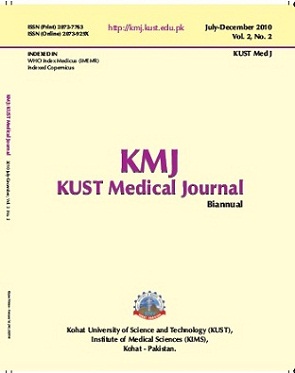ETIOLOGY, PRESENTATION AND OUTCOME OF HEAD INJURY PATIENTS ADMITTED IN AYUB TEACHING HOSPITAL ABBOTTABAD
Main Article Content
Abstract
Objective: To study the etiological factors, severity according to Glasgow coma scale, management and outcome of the head injury patients admitted in Neurosurgery Unit of Ayub Teaching Hospital, Abbottabad.
Material and Methods: This descriptive cross sectional survey was conducted in Department of Neurosurgery Ayub Teaching Hospital, Abbottabad from 1st January to 30th June 2008, including all patients admitted with head injury. Demographic profile, etiology, GCS at presentation, surgical procedure if performed, complication and hospital stay in days were recorded. Data was entered in specially designed proforma and analyzed by SPSS version 12.
Results: Out of 197 patients, 155(78.68%) were male while 42 (21.32%) were females, with a mean age of 21.2 years. The most common cause of head injury was road traffic accidents accounting for 107 (54.31%) patients followed by fall from height in 74 (37.56%) cases. On CT scan head, 51(25.89%) patients had concussion injury, 47 (23.86%) patients had extradural haematoma, 44 (22.33%) patients had cerebral contusion, 28 (14.21) patients had diffuse axonal injury, 14 (7.11%) patients had acute subdural haematoma. Out of 197 patients, 103 (52.28%) patients had mild head injury and 35 (17.77%) had severe head injury. Forty one (20.81%) patients required surgery while 156(79.19%) patients were managed conservatively. Mortality rate was 17.26% (n=34/197). Mean hospital stay was 7.30days.
Conclusion: Head injury frequently affects young males. Most frequent cause is road traffic accidents. Majority of cases had mild head injury and managed conservatively. Severe head injury is associated with significant morbidity and mortality.
Key Words: Head Injury, Extradural Haematoma, Subdural Haematoma, Cerebral Contusion, Concussion, Road Traffic Accident.
Article Details
Work published in KMUJ is licensed under a
Creative Commons Attribution 4.0 License
Authors are permitted and encouraged to post their work online (e.g., in institutional repositories or on their website) prior to and during the submission process, as it can lead to productive exchanges, as well as earlier and greater citation of published work.
(e.g., in institutional repositories or on their website) prior to and during the submission process, as it can lead to productive exchanges, as well as earlier and greater citation of published work.
